How do you know if your organization is effective enough and living to its full potential?
For small businesses, it might be simple. If you’re making money, paying staff, and getting clients, things are going ok.
But as a company grows, with diverse business units, and sustainable profits, the best ways to measure success become more difficult. That’s where the concept of organizational effectiveness comes in. As we will see (below), organizational effectiveness is a big concept that helps leaders define what matters – and how well they reach those goals.
In short, it’s fair to say that understanding organizational effectiveness is crucial to sustainable business activity today.
In this complete guide, we will:
- Define organizational effectiveness
- Explain five key ways to achieve organizational effectiveness
- Analyze some key models for measuring organizational effectiveness
- Examine the role of employees in organizational effectiveness.
Measures of effectiveness are changing all the time. And in 2023, steps like resilience, agility, and digital maturity could be more important than ever. Although this article will help you understand the basics, you must keep updating your knowledge for every niche industry.
What Is Organizational Effectiveness?
Organizational effectiveness is how far an organization’s current ability to meet its own goals. Organizational effectiveness is often defined financially through profits, efficiency, or growth. However, effectiveness can also be about staff retention, job experience, community impact, or market share.
Of course, measuring organizational performance is a vital part of any business. But every leader must define organizational effectiveness for their own company. There is a lot of writing to help leaders understand what effectiveness means in their context. And some organizations are now creating Organizational Effectiveness Offices (or OEOs) to ensure they make the right choices.
Why is Organizational Effectiveness Important?
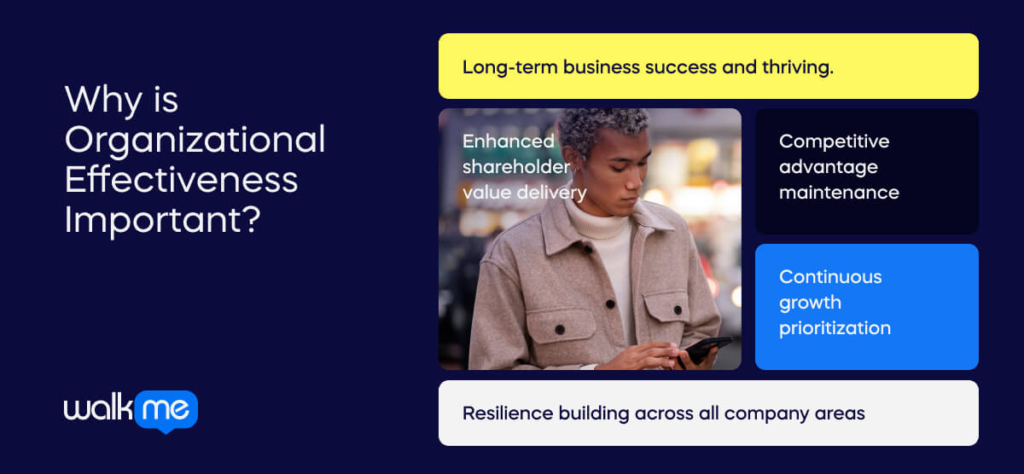
Creating a successful organization means achieving organizational effectiveness. Improving your company’s ability to reach its goals is critical to delivering shareholder value. It means your business will thrive long term.
However, maintaining a competitive advantage means regularly assessing organizational effectiveness and isn’t something you achieve and forget about. Companies must continually question the efficiency of their operations, employee performance, and leadership styles.
When facing disruptions, organizational efficiency can make all the difference. Your company can face challenges head-on and prioritize continuous growth. By committing to organizational effectiveness, your company will build resilience. This process involves all company areas, from senior leaders to staff.
But how can you create a more effective organization?
Five ways to Maximize Organizational Effectiveness
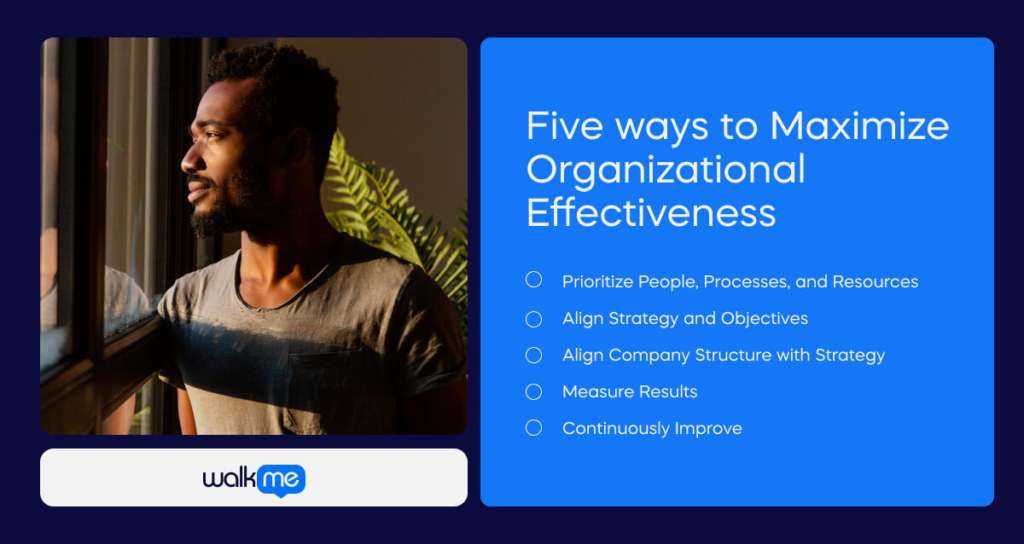
To gain a competitive advantage, you must approach organizational effectiveness holistically. Encouraging enterprise-wide collaboration is complex. Employees, leadership, processes, and culture must work in tandem.
Think of each of these areas as pillars supporting a large structure. Any weak areas threaten the stability of the entire organization.
How can you ensure strength and cohesion across an enterprise? We’ve put together five helpful strategies for maximizing organizational effectiveness.
1) Prioritize People, Processes, and Resources
Are employees motivated and productive? Or do they consistently fail to engage in tasks? Performance depends on several factors like the quality of employee training, the work environment, tools, and effective management.
Employees and leaders are ineffective without efficient processes. Operations should be fast, lean, and cost-effective. Staff also rely on operational efficiency to do their work. Employees, management, and processes must align to be effective. Gartner’s research shows that when ‘employee goals are aligned to both organizational and employee needs, employee performance increases by up to 22%.’
2) Align Strategy and Objectives
Many organizations undergo large-scale transformations to achieve organizational effectiveness. But many organizations don’t improve at the desired rate because they fail to align strategy with objectives.
Once you understand your organization’s value chain, you can adjust it to align with your objectives. Different approaches to reorganization depend on specific business models, but the key is being open to change.
For example, could you provide a better customer experience through automation? Tech-savvy customers often prefer online automation platforms as the chosen method of interaction with a company. A change like this would involve an implementation strategy, change management expertise, and executive buy-in.
Balancing all these moving parts can be complex, and businesses often neglect to address their company objectives throughout the process. Aligning strategy and goals helps your organization to make necessary changes to organizational structure.
3) Align Company Structure with Strategy
After prioritizing objectives, you can start aligning company structure with strategy. Organizational structure dramatically impacts an organization’s performance. For example, is the organization a top-down, autocratic hierarchy? Or is it democratic, composed of autonomous teams and individuals?
Finding the best structure and design for your model is crucial to becoming an effective organization. The system of leadership, management, culture, and other factors contribute to how well functions work together. For example, if employees don’t engage with new work systems, then processes become stalled.
Your organization needs an effective structure model to simultaneously engage all levels of the business. A holistic approach is the best way to ensure organizational inefficiencies don’t slow down the company.
4) Measure Results
How do you know if your efforts are paying off? Assessing organizational effectiveness isn’t as simple as looking at profits. Data analysis can be an important way to determine efficiency, but it’s equally important to focus on the human side of organizational growth.
If you want to measure organizational effectiveness accurately, you must ask the following questions:
- What goals are your company trying to achieve?
- Are these goals clearly communicated to employees?
- How often will you evaluate progress?
Maintaining transparency is the best way to engage employees in your efforts to achieve organizational effectiveness. Set out the roles and responsibilities of everyone involved and share the progress of your strategy at regular intervals, which will motivate everyone to keep pushing forward.
5) Continuously Improve
Organizational effectiveness is a continuous process. If you want your organization to commit to the process, you need support from the top. Executive support has a trickle-down effect throughout an enterprise, encouraging everyone to get on board with change initiatives and transformations.
A clear and consistent commitment from leaders is the best way to ensure your organization continues to improve. Remember to evaluate progress regularly and always look for areas of improvement.
Organizational Effectiveness Models and Approaches
The Canadian Center of Science and Education reviewed four separate models of organizational effectiveness. This study, which focused on organizational effectiveness within higher education, included:
- The Goal Approach – Defining effectiveness based on organizational objectives such as profit, innovation, and profit quality.
- The System Resource Approach – This model explains effectiveness based on an organization’s ability to obtain necessary resources.
- The Process Approach – This approach focuses on the efficiency and effectiveness of the processes within an organization.
- The Strategic Constituency Approach – This model defines effectiveness based on the stakeholders’ interests.
These approaches just scratch the surface.
Production, Commitment, Leadership, and Interpersonal Relationships
Dr. P. Venkataiah at Osmania University created this model that focuses on crucial components in an organization, such as:
- Production. The flow of organizational output.
- Commitment. How attached workers were to the organization.
- Leadership. Personal ability and influence.
- Interpersonal conflict. Perceived misunderstandings between supervisors and subordinates.
The underlying theme is evident. Efficiency, harmony, and effectiveness in various areas contribute to organizational effectiveness. More effective organizations are more profitable, resilient, and competitive.
Decision-Making, Learning, Group Effectiveness, and Adaptive Systems
This model relies on four critical criteria for success.
- Decision-making. How people make decisions, the quality of that decision-making, and improving decision-making by leveraging additional choices.
- Change and learning. How do people change, learn and adopt new information and modes of operating?
- Group effectiveness. How people work together as teams and how they leverage new ideas and innovations.
- Self-organizing and adaptive systems. How systems and processes evolve, self-organize, and improve the organization over time.
The Six Steps of Organization Effectiveness Leadership
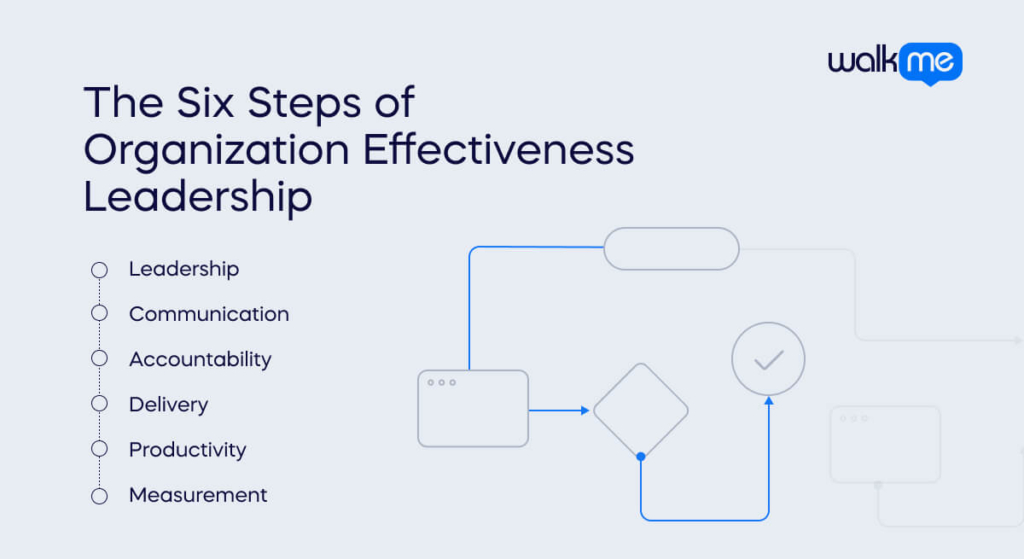
According to The Leadership Circle, organizational effectiveness depends on leadership.
Specifically, it depends on six systems:
- Leadership – Leaders must be able to translate vision into strategy, processes, and objectives.
- Communication – Communication should be strategic and consistent and attain results.
- Accountability – Maintaining accountability and discipline requires systems with real consequences and tangible rewards.
- Delivery – Operations must stay aligned with strategy, continuously improve, and build future capabilities, among other things.
- Productivity – Employee productivity should also be a methodical, systematic approach designed to attract, develop, and retain top talent.
- Measurement – To stay on track, a company should systematically apply metrics, reviews, and adjustments.
Engage Employees with Performance Accountability Systems
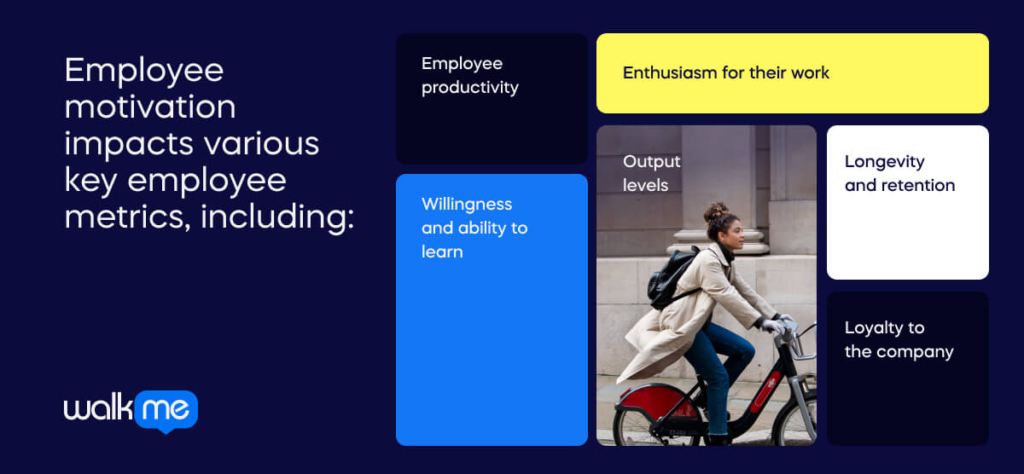
While the Leadership Circle emphasizes effective leadership as the axle around which organizational effectiveness revolves, others emphasize the role of employees.
Employee motivation is often cited as a key contributor to effective organizational performance. In a workplace context, motivation is critical.
Employee motivation contributes to many other critical employee metrics, such as:
- Employee productivity
- Enthusiasm for their work
- Output levels
- Willingness and ability to learn
- Longevity and retention
- Loyalty to the company
This is one reason why employee motivation receives so much attention from business leaders.
The Employee Experience
How do you maximize employee productivity? The employee experience should receive special attention.
Improving these areas can help increase organizational effectiveness – regardless of your model.
- The employee life cycle. The employee life cycle covers every interaction an employee has with a brand. This cycle begins with pre-recruitment contact and includes other stages of interaction, from onboarding through to post-exit surveys.
- The employee experience. The employee experience includes the employee life cycle. But, depending on who you ask, it can also include the workplace environment, career development programs, interpersonal relationships, and any other aspect of a worker’s experience within the company.
- Career and skills development. Human resources have extended its role into change management, employee experience, training, and career development. This shift in responsibility has also transformed it into a value-added function – not just an administrative or managerial role.
- Employee behavior. Employee behavior affects how individuals and teams interact. Expectations around behavior should be clear and goal-oriented. Appropriate workplace behavior contributes to team morale, creating more efficient, effective, and productive units.
How To Assess Organizational Effectiveness
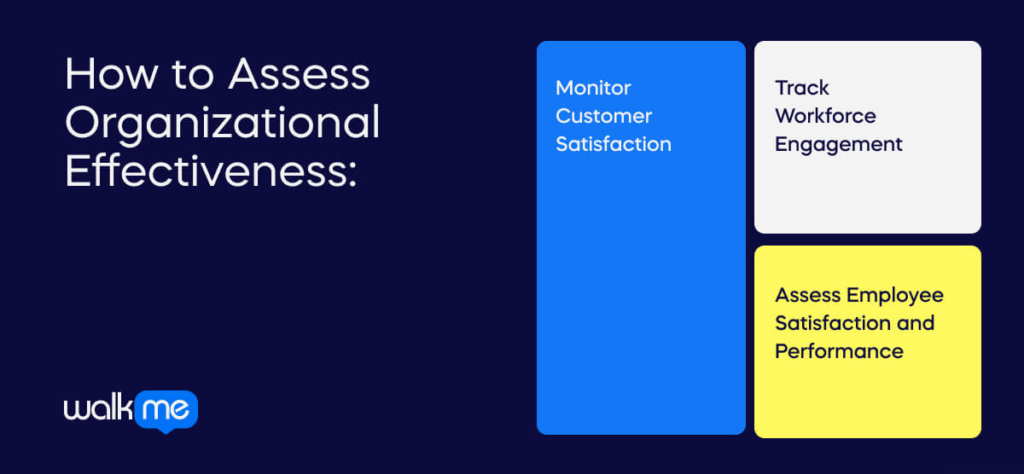
Monitoring progress is vital to ensure long-lasting results. But if you don’t know where to look, it can be hard to determine if your strategy is working. Besides comparing net profit to desired profit records, how else can you measure organizational effectiveness?
One of the first indicators to look at is customer satisfaction. An effective organization provides quality services to its customers. Internal processes directly impact the quality of service a company offers. Ask your customers if you want to know how effective your organization is.
Workforce engagement is another measurement system used to track progress. Are employees engaged in new workflows? Are they happy using the latest software? Internal processes run more smoothly when employees perform well.
By assessing employee satisfaction and performance, you’ll determine your organizational structure’s effectiveness. Employee and customer satisfaction are key performance indicators and a great place to start if you want to improve organizational effectiveness.
Change Management Leads to a More Effective Organization
In this article, we’ve learned a few of the most important lessons about organizational effectiveness.
It’s an open-ended concept that helps to organize all your thinking about performance and delivery. Organizational effectiveness depends on strategic approaches to planning, staff engagement, and more. And it doesn’t make much difference if you don’t measure it properly.
In closing, we should remember one key feature of organizational effectiveness. When you define effectiveness, you are making major decisions about your company. Those decisions might dictate broader organizational changes you need to make.
The most successful approaches to change, the overall intentions of a project, are matched to the strategies used to achieve them. Change management must come from the top. McKinsey’s report on CIO perspectives and leading agile change shows that ‘when the top team deeply understands what agility is and how it creates value, the transformation’s chances of success increase by at least 30 percent.’
In this context, organizational effectiveness is not just about keeping the status quo: it’s about building a future that works for your business.

